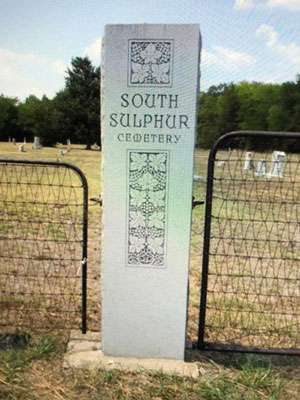
Last weekend we slipped out of our In-Shelter place and went for a drive. South Sulphur Cemetery was our goal, but we investigated other spots in northeast Hunt County along the way. It was a pleasant Sunday morning, with lots to see.
Our goal was a small country cemetery located near South Sulphur Creek that heads near the cemetery and flows into the Middle Sulphur River east of Commerce. They, in turn, flow into North Sulphur Creek to create the Sulphur River. The Sulphur River flows into the Red River in Arkansas on its way to the Gulf of Mexico.
A small community grew around the cemetery. The post at the cemetery gate informs visitors that the cemetery was first used as a burial ground in 1850. That makes it one of the oldest in Hunt County. The cemetery is neatly mowed with no visible tombstones overturned. The ample ground space along with the knowledge of the first grave indicates that there are probably several unmarked graves inside the fence. I didn’t walk around the fence looking for outlaw graves, those who were buried outside the fence.
The earliest pioneers settled near what is today the cemetery. To the north and west was a wooded area known as Black Cat Thicket. It was a hideout for outlaws before and after the Civil War, and during the war it was a refuge for deserters, both north and south. In the 1870s, Hunt County and neighboring areas wished, hoped, and petitioned for a railroad. They knew the soil was superb for raising cotton, but with no way to ship the cotton to market, there was no reason to grow a crop. In 1873 the disastrous recession took finances from the railroads and everyone else. No tracks were laid for rest of the decade.
But 1880 came in with a boom, the railroad came from Denison to Greenville and on to Jefferson, a river port for cotton. Other tracks led to Galveston, the big cotton port. It was at that time farmers changed from raising livestock, wheat, and corn to cotton. From 1880 to the First World War in 1914, farmers plowed and planted cotton. And all the time, the price of cotton dropped more and more. By the Great Depression of the 1930s, cotton was bringing five cents a pound.
After World War II, farmers living around South Sulphur began to try various other crops. Along our drive we saw where wheat had been harvested and then the stalks plowed under to supplement the soil. Almost every house had bales of hay around the barn, waiting for horse farmers from the Denton area to purchase their fine crops. Acres and acres of corn and soybeans were just about ready to be harvested. As we went through Wolfe City, we saw a large pecan orchard in the Short Creek bottom. It’s been there since the 1970s, I know.
This is the farming region of Hunt County.
Several homes dotted the landscape. All were neatly mowed, trash picked up, and vegetables in the gardens on their last leg with the weather warming up. We even crossed Turkey Creek; I suspect it was named for all the wild turkeys. I highly recommend Sunday drives like this for a safe opportunity to get out of the house, while still isolated.
The only other part of the county I am not well acquainted with is the southwest part. One of these days I’ll get my chauffeur to drive down that way. He is extremely knowledgeable about crops and is a very good husband.
